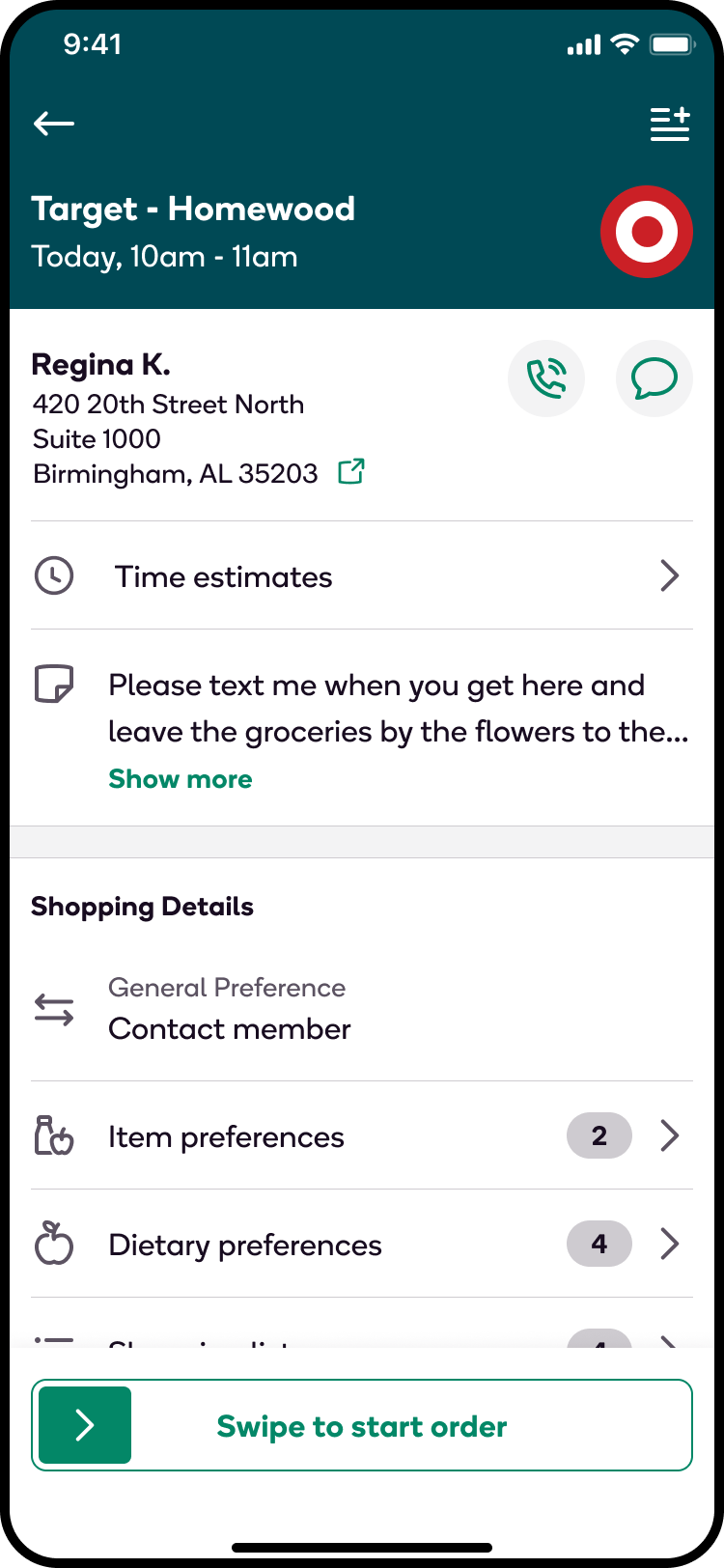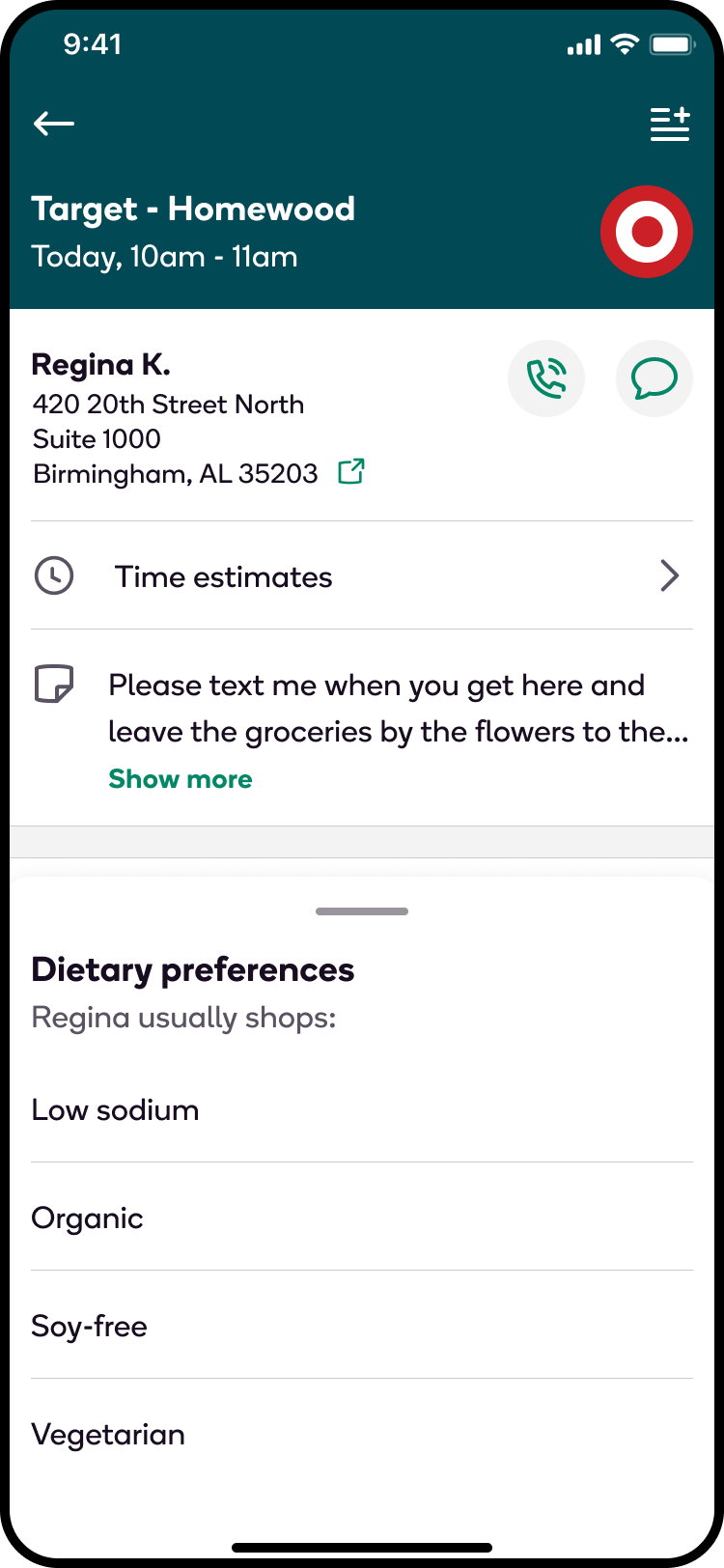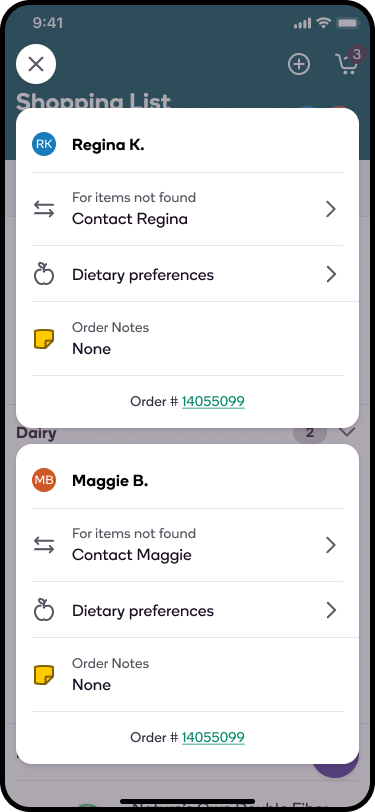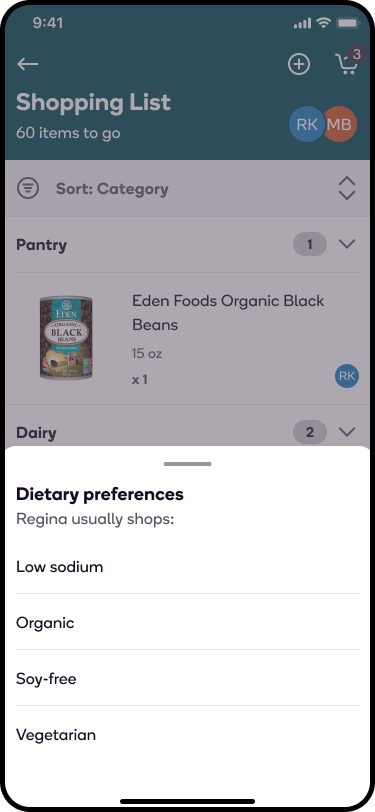Members have the ability to set dietary preferences for their account, which enables them to get recommendations for foods they may prefer while placing an order.
If a member has set their dietary preferences for their account, you will be able to review them after claiming their order. While shopping, you’ll also see specific preferences listed under items when searching for an item to add or substitute. The app will recommend items based on the member’s preferences, where preferred items will display at the top of the Recommended Items list to help you easily find items that members will love first. This gives you one more opportunity to strike a connection with members.
- To review the list of a member's dietary preferences, tap Dietary preferences in the Shopping Details section of the Order Details screen. A modal will display at the bottom of the screen.
- You can also access it from the top of the Item search screen, above the recommended items.
*Note: If you do not see dietary preferences listed for an order, it means the member has not set dietary preferences for their account.


.png)
If shopping a bundle, the list of preferences for each member will be accessible to review by tapping the member icons at the top of the Shopping List and then Dietary preferences.


Understanding Dietary Preferences
To learn about each dietary preference that you may see listed for a member as well as what items the member may prefer or avoid based on their preferences, review the information below.
Diet Preferences
- Atkins: The Atkins diet emphasizes a low carb intake and a high fat and protein intake. People who prefer an Atkins diet typically avoid bread and grains in favor of meat and dairy products. Learn more.
- DASH Diet: DASH stands for Dietary Approaches to Stop Hypertension. People who prefer a DASH diet typically eat fruits, vegetables, and lean meats while avoiding sodium, sugar, and red meat. Learn More.
- Keto: The Keto diet emphasizes a low carb intake and a high fat intake. People who prefer a Keto diet typically avoid bread and grains in favor of meat and dairy products. Learn More.
- Kosher: Rooted in Jewish traditions, Kosher foods typically avoid certain meats such as pork and shellfish and do not contain both meat and dairy products. Learn More.
- Mediterranean: The Mediterranean diet includes whole grains, healthy fats (such as from nuts, olive oil, and fish) and/or plants based on whole foods. People who prefer a Mediterranean diet typically eat a higher volume of plant-based foods than animal-based foods and avoid high sodium. Learn More.
- Paleo: People who prefer a paleo diet typically eat animal and plant-based foods while avoiding processed food. Learn More.
- Pescatarian: Pescatarianism typically relies on fish and other seafood as the only type of meat that is consumed. Learn More.
- Vegan: Veganism typically avoids the consumption of any items that contain animal products. Learn More.
- Vegetarian: Vegetarianism typically avoids the consumption of any products containing meat, poultry, or seafood. Learn More.
- Gluten Free: People who prefer to eat gluten free typically avoid any products containing gluten. Gluten is found in wheat, barley, rye, and oats. Learn More.
Label Preferences
- AHA Heart Healthy: Items labeled as AHA Heart Healthy indicate that they meet health requirements from the American Heart Association based on the amount of fat they contain.
- Low Sodium: Items labeled “low sodium” will contain 140g milligrams or less of sodium per serving.
- No Added Sugar: Items labeled “no added sugar” do not contain any added sweeteners, although they may still contain sugar.
- Non-GMO: GMO stands for Genetically Modified Organisms. Items labeled “non-GMO” are products whose genetic material has not been manipulated.
- Organic: Items labeled “organic” have been grown naturally without the use of synthetic chemicals such as pesticides.
- Soy-free: Items labeled “soy-free” do not have soy listed on the ingredients list.
- Sugar-free: Items labeled “sugar-free” contain less than 0.5 grams of sugar per serving.
-
Wheat-free: Items labeled “wheat-free” do not have wheat listed on the ingredients list.*
- *Note: Items that are wheat-free may not be gluten free.
- Whole Grain: Items labeled “whole grain” contain a whole grain as the first ingredient where the second ingredient is not added sugar.
*Note: Shipt relies on third-party suppliers to provide dietary and safety information, including allergens and general product descriptions. We cannot guarantee that our information is accurate or complete, and do not assume liability for adverse reactions for purchased items.
